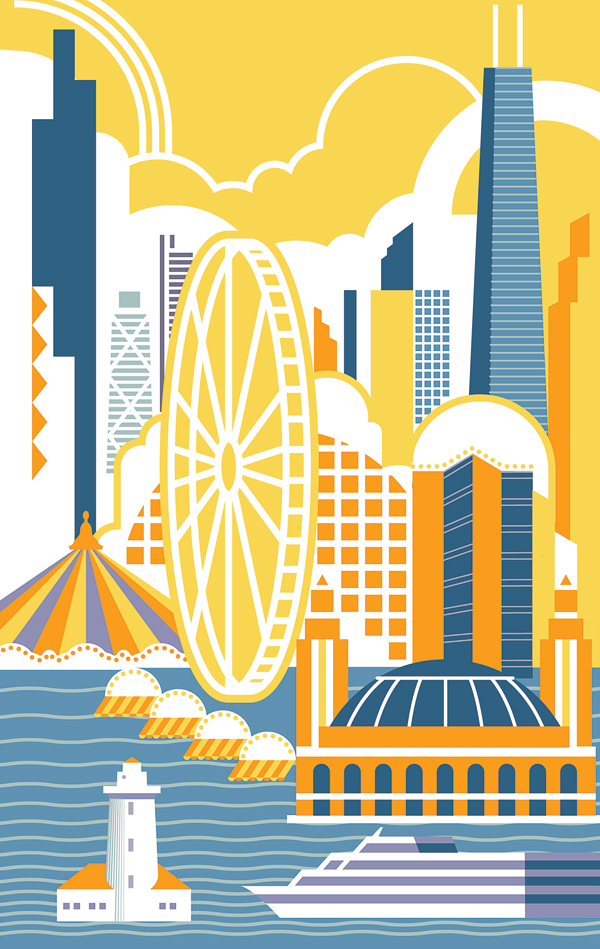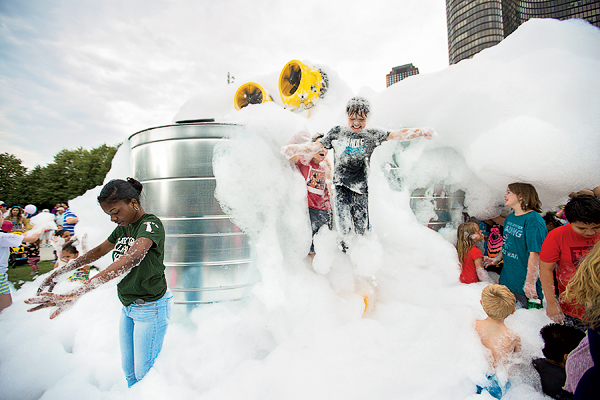
Public radio icon Ira Glass worked at WBEZ’s office on Navy Pier for 11 years before moving to New York in 2006. Suffice it to say, he was not a fan of the Navy Pier experience. “It was horrible,” says the host and executive producer of the Peabody Award–winning radio show This American Life. “It was like a low-rent theme park with terrible food, and it was depressing.” In the unkindest cut of all, he likens the pier’s collection of tchotchke stands and chain restaurants to a tourist trap in Davenport, Iowa. Ouch.
Glass isn’t wrong. More than a decade later, some locals wear it as a badge of pride that they’ve never set foot on Navy Pier or paid good money to gape at the skyline from its Ferris wheel. Compared with more sophisticated tourist destinations nearby (say, Millennium Park or the Art Institute), Navy Pier has long been viewed by Chicagoans as that overbearing brother-in-law who wears acid-wash jorts and a Japanese flag cutoff T-shirt.
That’s about to change, says Michelle T. Boone, who took over as Navy Pier’s chief program and civic engagement officer last summer. Just bringing her aboard shows the city is serious: The no-nonsense Boone spent five years as commissioner of the Department of Cultural Affairs and Special Events. As the culture czar, she helmed the highly successful 2012 effort to boost the city’s arts sector and oversaw the inaugural Chicago Architecture Biennial in 2015. “The vision,” says Boone, “is to bring the pier to a place of elegance and accessibility that hadn’t been here before.” In other words, to make Navy Pier cool.
Is that even possible? For decades, Navy Pier was a white elephant no one really knew what to do with. It opened in 1916 as a dock for freight and passenger ships. Since then, the pier, more than half a mile long, has variously housed an emergency hospital, a prison for draft dodgers, a branch of the University of Illinois, and, in the late ’70s, the short-lived ChicagoFest, which lured acts like Cheap Trick and Alice Cooper. Named an official Chicago landmark in 1977, the pier entered its current incarnation in 1995 and now draws more than nine million people a year, making it one of the most visited spots in the Midwest. The ride-hailing service Lyft declared it the top tourist destination in the country in 2016, based on the number of rides booked to the site.
Despite that success, there’s long been a disconnect between the pier and the rest of the city. To be blunt, it felt like Schaumburg in Chicago. Just a few years ago, Boone says, she herself avoided the place: “If I had family in town and they wanted to go, I’d drop them off and say, ‘Tell me what time you want me to pick you up.’ ” Even now, her enthusiasm wanes some as she walks through the unrenovated area just inside the main entrance, which is filled with kiosks selling henna tattoos and “I [Heart] Navy Pier” stuffed animals. “This is the next phase of the redesign,” she says flatly. In the meantime, she explains, “we’re taking what was good and reshaping it into something great.”
The changes are buoyed by a recent Polk Bros. Foundation donation of $20 million, which led to a face-lift for the front of the pier that included a new 12,500-square-foot fountain. Aside from that, perhaps the most obvious improvement is the 198-foot Centennial Wheel, which replaced the smaller, less impressive version and debuted last spring amid much fanfare. The upshot: less carnival ride, more sleek “experience.”
Boone then points out the new Wave Wall, a gently curving staircase that evokes Rome’s Spanish Steps and looks out over the lake, and the Chicago Shakespeare Theater, undergoing an innovative $35 million revamp to create nine movable seating towers that will allow a huge variety of stage configurations. “That’s a total game-changer,” she says of the project, an undertaking of the renowned Chicago-based Adrian Smith + Gordon Gill Architecture, the firm behind some of the world’s tallest buildings, including the Burj Khalifa.
Less flashy but arguably more attractive to locals is the addition of new stages near the pier’s entrance where people can sprawl on a sloped lawn and watch performances sponsored by the Jazz Institute of Chicago or movies from the Chicago International Film Festival; platforms scattered along the south dock of the pier for musical ensembles or dance troupes; and Sunday evening yoga classes. Cynics can’t even sneer (for long) at the food options anymore. While Bubba Gump Shrimp Co. isn’t vanishing, the food court (er, “food experience”) is now peppered with outposts from local favorites Goddess and the Baker, Brown Sugar Bakery, and DMK Burger and Fish Bar and even a craft cocktail spot by Tiny Lounge called—what else—Tiny Tavern. “You can still get your cinnamon nuts or your Garrett’s popcorn, but for those with, ahem, more sophisticated taste buds, we’ve got them covered, too,” Boone says.
That’s indicative of Navy Pier’s broader mandate to satiate the souvenir-collecting masses while boosting the city’s cultural cred as a stimulating place for locals to hang out. “I want Chicagoans to embrace the pier as their own and not think about it as ‘that place for tourists,’ ” says Boone. “I want them to think, It’s my pier and I want to be there—I want to see my favorite band or dance company.”
Indeed, the changes might even win over Glass, who admits they sound pretty impressive: “I wouldn’t bet against this place.”
Five More Legit Reasons to Visit Navy Pier

1. Go to a foam party.
Not the kind from your rave days. This large-scale art installation spews massive quantities of suds from giant steel canisters. The artist, Roger Hiorns, was going for a depiction of “continuous change in a joyous ebullient manner.” Sounds like a foam party to us. Polk Bros Park, through October 21, weekdays at noon and weekends at noon and 4 p.m.
2. Watch the masters at work.
Here’s where it starts getting really good: Powerhouse architect Jeanne Gang (of Aqua Tower and Chicago River boathouse fame) and acclaimed visual artist Nick Cave (creator of the legendary Soundsuits) collaborate with local musicians on an art, design, and performance extravaganza as part of the Chicago Architecture Biennial and Expo Chicago. Aon Grand Ballroom, September 13 at 8 p.m., and Polk Bros Performance Lawns, September 16 at 5 p.m.
3. Get inspired.
Speaking of Expo Chicago: Sit in on a panel or attend the symposium to go behind the scenes with curators, creatives, and visionaries, like Felix Burrichter, founder of the architectural entertainment magazine Pin-Up, and Iraqi American Michael Rakowitz, the artist who ran Chicago’s first Iraqi food truck, Enemy Kitchen. Festival Hall, September 13 to 17
4. Buy some art.
As in, the real deal—not tourist trinkets—at SOFA Chicago, the annual functional design fair. Your foyer needs a little something to spruce it up, right? Ceramics, glass, wood, metal—take your pick at nearly 70 galleries. Festival Hall, November 2 to 5
5. Rock out with Jingle Jamz.
Well, some things never change. Cultural Corner, December 2, 9, 16, and 23 at 5 p.m.


